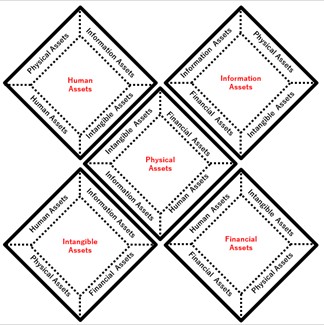The Truth, the Whole Truth and
Nothing but the Truth…?
COMMENTARY
By Dr. Paul D. Giammalvo
Jakarta, Indonesia
While I REALLY appreciate so many “big names”[1] [2] in Project Management starting to provide both explicit and implicit acknowledgment and support for the critical role that asset management and asset managers play in the world of project management, this closing statement by Alan Stretton that “it helped me understand a little more about the nature of various types of assets that are relevant to the project and allied contexts, and I hope it may do the same for at least some others”[3] along with several debates on LinkedIn alerted me to other important considerations or basic fundamental principles or “TRUTHS” that I have not covered as adequately or completely as I could or should have, leaving many apparent “gaps” in the understanding of the all the “actors” in project management, and those 8 “TRUTHS “are:
Truth #1 – Projects, whether viewed from the perspective of a CONTRACTOR or as an OWNER or even in our day-to-day PERSONAL lives, are undertaken for two reasons and two reasons only, and those are:
- To FIX (or in the case of government regulations) AVOID a real (or perceived) problem or;
- To EXPLOIT a real (or perceived) opportunity.
Truth #2 – It “takes ASSETS to CREATE new or more assets”- that assets are not “created, acquired, updated, expanded, maintained, repaired and eventually disposed of” out of thin air but require the initial application of organizational assets to support or “kick-off” the process and sustain the process over the entire life SPAN of both the project and the life SPAN of the Asset the project was undertaken to create.
Truth #3 – For an OWNER organization, project management is generally NOT a “core competency” but nothing more than a “necessary evil”[4]– a process to be tolerated or endured” until the ASSET the OWNER or SPONSOR needs to “solve or avoid the problem” or “exploit the opportunity” is completed and ready to be put in service. For OWNERS, a project is a COST or INVESTMENT center. The only entities who see projects as PROFIT centers are the CONTRACTORS, their SUBCONTRACTORS, CONSULTANTS, VENDORS and SUPPLIERS. Evidence supporting this can be seen by the number of OWNER organizations, who, given a choice, prefer to OUTSOURCE “project management” to CONTRACTORS. While this has been a common practice in construction, medicine, and entertainment, it has yet to gain widespread acceptance in IT and New Product Development, at least up until now.

Figure 1 – Asset/Resource Categories[5]
Likewise, knowing that used in the context of integrated “asset, portfolio, operations (program) and project management” that “assets” can be used synonymously with “resources,” and we also know there are five generic asset classes or categories:
- Human Resources– Obviously enough, these are a key element of any project, not only in the INPUT side of the equation (Initiation and Planning) but also on the “Execution” (solving the problem or exploiting the opportunity) and also on the OUTPUT side of the equation (Closing processes)
- Information or Knowledge Resources. Likewise, Informational or Knowledge Resources also permeate the entire process, from start to finish.
- Physical Resources– Worth noting is these do not only include the tools, physical plant and the equipment being used, but for our software colleagues, according to Investopedia, “while software is not physical or tangible in the traditional sense, accounting rules allow businesses to capitalize software as if it were a tangible asset.”[6]
- Financial Resources– Again, this should be patently obvious that without money to pay salaries, pay the electricity and heating bills, not to mention buying the materials and equipment, that no project can be undertaken either by an OWNER or CONTRACTOR without financial resources. This is the reason why most OWNERS require CONTRACTORS to post PERFORMANCE BONDS, ensuring they have the financial horsepower to undertake and finish the project.
- Lastly, we have INTANGIBLE Resources, which is the “brand image” important to both OWNERS and CONTRACTORS alike. How many of you would not be proud to show that you worked on the Burj Khalifa as either a CONTRACTOR or OWNER? Likewise, how many of you would be eager to have your names attached to the recent US troop withdrawal from Afghanistan or the Wuhan Laboratory? Never forget that in project management, “you are only as good as your last project.”
In Figure 2, we can begin to understand and appreciate just how closely integrated the need for all five categories of ASSETS are as being essential as the ENGINE or “ENABLERS” underlying ALL project management processes. How so many professional societies have managed to overlook or ignore this essential relationship remains a huge mystery. Worse yet, judging by the resistance on Linked In debates, it doesn’t seem likely to change for the foreseeable future.
More…
To read entire article, click here
How to cite this work: Giammalvo, P.D. (2021). “Principle-Based Project Management”: The Truth, the Whole Truth and Nothing But the Truth? PM World Journal, Vol. X, Issue XI, November. Available online at https://pmworldlibrary.net/wp-content/uploads/2021/11/pmwj111-Nov2021-Giammalvo-principle-based-project-management-the-whole-truth.pdf
About the Author

Dr. Paul D. Giammalvo, CDT, CCE, MScPM, MRICS
Jakarta, Indonesia
![]()
![]()
![]()
![]()
![]()
Dr. Paul D. Giammalvo, CDT, CCE (#1240), MScPM, MRICS, is a Senior Technical Advisor (Project Management) to PT Mitratata Citragraha. (PTMC), Jakarta, Indonesia. www.build-project-management-competency.com. He is noted for the development and delivery of graduate level, blended learning curricula designed for the mid-career path, English as Second Language (ESL) professionals to develop competency in the local practitioner and build capacity for the local organizations. For 25+ years, he has been developing and delivering Project Management training and consulting throughout South and Eastern Asia Pacific, the Middle East, West Africa, and Europe.
He is also active in the Global Project Management Community, by playing a “thought leadership” role for the Association for the Advancement of Cost Engineering International, (AACEI) http://www.aacei.org/ since 1991; He has also been active in two IPMA member organizations: The Green Project Management Association (GPM) http://www.greenprojectmanagement.org/ where he served on the Certification Board of Directors for two years and the American Society for the Advancement of Project Management http://www.asapm.org/ for which he served for four years on the BoD as Director of Marketing. He also sat on the Board of Directors of the Global Alliance for Project Performance Standards (GAPPS), www.globalpmstandards.org, Sydney, Australia and is active as a regional leader. Currently, he is a compensated consultant to the International Guild of Project Controls. http://www.planningplanet.com/guild as the primary author of their “Compendium and Reference” as well as the chief architect of their competency-based credentialing program. http://www.planningplanet.com/guild/certification
He has spent 35 of the last 50 years working on large, highly technical international projects, including such prestigious projects as the Alyeska Pipeline and the Distant Early Warning Site (DEW Line), upgrades in Alaska and the Negev Airbase Constructors, Ovda, Israel and the Minas Oil Field in Rumbai, Sumatra. His current client list includes Fortune 500 major telecommunications, oil, gas and mining companies plus the UN Projects Office and many other multi-national companies, NGO organizations and Indonesian Government Agencies.
In addition to 45+ years of hands-on field experience, Dr. Giammalvo holds an undergraduate degree in Construction Management, his Master of Science in Project Management through the George Washington University and was awarded his PhD in Project and Program Management through the Institute Superieur De Gestion Industrielle (ISGI) and Ecole Superieure De Commerce De Lille (ESC-Lille) under the supervision of Professor Christophe Bredillet. “Dr. PDG” can be contacted at pauldgphd@gmail.com.
To view other original work by Paul Giammalvo, visit his author showcase in the PM World Library at http://pmworldlibrary.net/authors/dr-paul-d-giammalvo/
[1] Giammalvo, P.D. (2021). The Bigger Picture: Project Life Cycles from a Broader, RealWorld Perspective; Commentary, PM World Journal, Vol. X, Issue VI, June. https://pmworldlibrary.net/wp-content/uploads/2021/06/pmwj106-Jun2021-Giammalvo-the-bigger-picture-commentary.pdf
[2] Giammalvo in Wideman “Project Management Caught in a 1960s Time Warp parts 1 and 2 http://www.maxwideman.com/guests/time_warp/intro.htm
[3] Stretton, A. (2021). An exploration of assets and projects: Types of assets, and project deliverables as assets, in an organisational context, PM World Journal, Vol. X, Issue X, October. Available online at https://pmworldlibrary.net/wp-content/uploads/2021/09/pmwj110-Oct2021-Stretton-assets-and-project-deliverables-in-organisational-context.pdf
[4] Dictionary of Idioms (N.D.) something unpleasant that must be done in order to achieve a goal or objective Source: theidioms.com This phrase goes back to the ancient Greek times. The first usage of the phrase “necessary evil” was with reference to Marriage. Source: theidioms.com
[5] Adapted from PAS 55.2, Figure 2- http://hadidavari.com/wp-content/uploads/2018/03/PAS-55-2-2008.pdf
[6] Investopedia https://www.investopedia.com/ask/answers/09/computer-software-intangible-asset.asp









